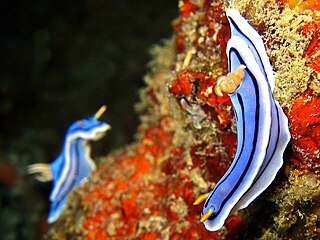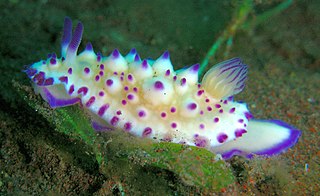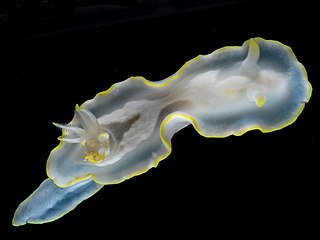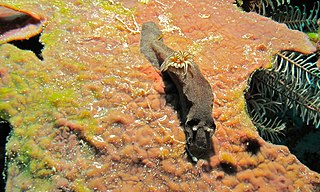
Chromodorididae, or chromodorids, are a taxonomic family of colourful sea slugs; dorid nudibranchs, marine gastropod mollusks in the superfamily Doridoidea. “Chromodorid nudibranchs are among the most gorgeously coloured of all animals.” The over 360 described species are primarily found in tropical and subtropical waters, as members of coral reef communities, specifically associated with their sponge prey. The chromodorids are the most speciose family of opisthobranchs. They range in size from <10mm to over 30 cm, although most species are approximately 15–30 mm in size.

Chromodoris is a genus of very colourful sea slugs or dorid nudibranchs, marine gastropod molluscs, and the type genus of the family Chromodorididae. Within the genus Chromodoris, there are currently 101 classified species. Species within Chromodoris are commonly found in tropical and subtropical waters, living as members of reef communities and preying primarily on sponges. A molecular phylogeny of the family Chromodorididae resulted in this genus being restricted to a smaller number of species than formerly, most of which have longitudinal black lines on the mantle. Many former members of Chromodoris were transferred to Goniobranchus

Doriprismatica sedna is a species of colorful sea slug, a dorid nudibranch, a marine gastropod mollusk in the family Chromodorididae.

Ardeadoris cruenta is a species of very colourful sea slug, a dorid nudibranch, a marine gastropod mollusc in the family Chromodorididae. Its name is derived from the feminine form of the Latin word cruentus, which means "stained with blood" and is a reference to the red spots on its upper dorsum. It was transferred to the genus Ardeadoris on the basis of DNA evidence.

Glossodoris is a genus of sea slugs, dorid nudibranchs, shell-less marine gastropod mollusks in the family Chromodorididae.

Doriprismatica atromarginata is a species of sea slug. It is a dorid nudibranch, a shell-less marine gastropod mollusk in the family Chromodorididae.

Mexichromis multituberculata is a species of sea slug, a dorid nudibranch, a shell-less marine gastropod mollusk in the family Chromodorididae.

Glossodoris pallida is a species of a nudibranch, a marine gastropod mollusc in the family Chromodorididae.

Goniobranchus bombayanus is a species of colourful sea slug, a dorid nudibranch, a marine gastropod mollusc in the family Chromodorididae.
Glossodoris aeruginosa is a species of sea slug, a dorid nudibranch, a shell-less marine gastropod mollusk in the family Chromodorididae.

Ardeadoris averni is a species of sea slug, a dorid nudibranch, a shell-less marine gastropod mollusc in the family Chromodorididae. It was transferred to the genus Ardeadoris on the basis of DNA evidence.
Ardeadoris carlsoni is a species of sea slug, a dorid nudibranch, a shell-less marine gastropod mollusc in the family Chromodorididae. It was transferred to the genus Ardeadoris on the basis of DNA evidence.
Doriprismatica plumbea is a species of sea slug, a dorid nudibranch, a shell-less marine gastropod mollusk in the family Chromodorididae.
Ardeadoris rubroannulata is a species of sea slug, a dorid nudibranch, a shell-less marine gastropod mollusk in the family Chromodorididae.
Doriprismatica sibogae is a species of sea slug, a dorid nudibranch, a shell-less marine gastropod mollusk in the family Chromodorididae.

Doriprismatica stellata is a species of sea slug, a dorid nudibranch, a shell-less marine gastropod mollusk in the family Chromodorididae.
Mexichromis lemniscata is a species of colourful sea slug or dorid nudibranch, a marine gastropod mollusk in the family Chromodorididae.
Mexichromis circumflava is a species of sea slug or dorid nudibranch, a marine gastropod mollusk in the family Chromodorididae.
Thorunna perplexa is a species of sea slug, a dorid nudibranch, a shell-less marine gastropod mollusk in the family Chromodorididae.

Chromolaichma is a genus of sea slugs, specifically dorid nudibranchs, shell-less marine gastropod mollusks in the family Chromodorididae.











